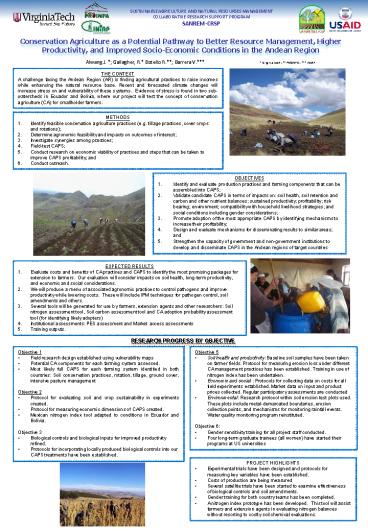Diapositiva 1 - PowerPoint PPT Presentation
Title:
Diapositiva 1
Description:
SUSTAINABLE AGRICULTURE AND NATURAL RESOURSES MANAGEMENT COLLABORATIVE RESEARCH SUPPORT PROGRAM SANREM-CRSP Conservation Agriculture as a Potential Pathway to Better ... – PowerPoint PPT presentation
Number of Views:35
Avg rating:3.0/5.0
Title: Diapositiva 1
1
SUSTAINABLE AGRICULTURE AND NATURAL RESOURSES
MANAGEMENT COLLABORATIVE RESEARCH SUPPORT
PROGRAM SANREM-CRSP
Conservation Agriculture as a Potential Pathway
to Better Resource Management, Higher
Productivity, and Improved Socio-Economic
Conditions in the Andean Region
Alwang J.
Gallagher, R. Botello R. Barrera V.
Virginia
Tech - PROINPA - INIAP
THE CONTEXT A challenge facing the Andean Region
(AR) is finding agricultural practices to raise
incomes while enhancing the natural resource
base. Recent and forecasted climate changes will
increase stress on and vulnerability of these
systems. Evidence of stress is found in two
sub-watersheds in Ecuador and Bolivia, where our
project will test the concept of conservation
agriculture (CA) for smallholder farmers.
- METHODS
- Identify feasible conservation agriculture
practices (e.g. tillage practices, cover crops
and rotations) - Determine agronomic feasibility and impacts on
outcomes of interest - Investigate synergies among practices
- Field-test CAPS
- Conduct research on economic viability of
practices and steps that can be taken to improve
CAPS profitability and - Conduct outreach.
- OBJECTIVES
- Identify and evaluate production practices and
farming components that can be assembled into
CAPS - Validate candidate CAPS in terms of impacts on
soil health, soil retention and carbon and other
nutrient balances sustained productivity
profitability risk bearing environment
compatibility with household livelihood
strategies and social conditions including
gender considerations - Promote adoption of the most appropriate CAPS by
identifying mechanisms to increase their
profitability - Design and evaluate mechanisms for disseminating
results to similar areas and - Strengthen the capacity of government and
non-government institutions to develop and
disseminate CAPS in the Andean regions of target
countries
- EXPECTED RESULTS
- Evaluate costs and benefits of CA practices and
CAPS to identify the most promising packages for
extension to farmers. Our evaluation will
consider impacts on soil health, long-term
productivity, and economic and social
considerations. - We will produce a menu of associated agronomic
practices to control pathogens and improve
productivity while lowering costs. These will
include IPM techniques for pathogen control, soil
amendments and others. - Several tools will be generated for use by
farmers, extension agents and other researchers
Soil nitrogen assessment tool, Soil carbon
assessment tool and CA adoption probability
assessment tool (for identifying likely adopters) - Institutional assessments PES assessment and
Market access assessments - Training outputs.
RESEARCH PROGRESS BY OBJECTIVE
- Objective 1
- Field research design established using
vulnerability maps - Potential CA components for each farming system
assessed. - Most likely full CAPS for each farming system
identified in both countries Soil conservation
practices, rotation, tillage, ground cover,
intensive pasture management - Objective 2
- Protocol for evaluating soil and crop
sustainability in experiments created. - Protocol for measuring economic dimensions of
CAPS created. - Mexican nitrogen index tool adapted to conditions
in Ecuador and Bolivia. - Objective 3
- Biological controls and biological inputs for
improved productivity refined. - Protocols for incorporating locally produced
biological controls into our CAPS treatments have
been established.
- Objective 5
- Soil health and productivity Baseline soil
samples have been taken on farmer fields.
Protocol for measuring erosion loss under
different CA management practices has been
established. Training in use of nitrogen index
has been undertaken. - Economic and social Protocols for collecting
data on costs for all field experiments
established. Market data on input and product
prices collected. Regular participatory
assessments are conducted - Environmental Research protocol within soil
erosion test plots used. These plots include
metal-demarcated boundaries, erosion collection
points, and mechanisms for monitoring rainfall
events. Water quality monitoring program
reinstituted. - Objective 6
- Gender sensitivity training for all project staff
conducted. - Four long-term graduate trainees (all women) have
started their programs at US universities
- PROJECT HIGHLIGHTS
- Experimental trials have been designed and
protocols for measuring key variables have been
established. - Costs of production are being measured
- Several satellite trials have been started to
examine effectiveness of biological controls and
soil amendments. - Gender training for both country teams has been
completed. - A nitrogen index prototype has been developed.
This tool will assist farmers and extension
agents in evaluating nitrogen balances without
resorting to costly soil chemical evaluations.































